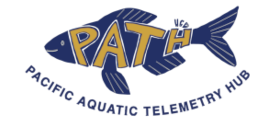FAQs
What are the benefits of submitting data to PATH?
PATH has joined forces with the Ocean Tracking Network (OTN) to provide collaborators with a whole suite of benefits. First, the use of standardized data templates ensures that all data submitted to PATH are in the same format and contain enough metadata that the important details and context of the study will be captured for future use. Next, all data submitted is passed through a series of quality control and assurance (QA/QC) scripts to ensure that the data meet quality standards and are associated with complete metadata via our relational database. Final data products are then made available in each collaborator’s repository folder on the PATH website in addition to being housed in the PATH SQL database. Additionally, there are data sharing policies in place so collaborators can decide if and when they want their data to be made public. All publicly available data are searchable and downloadable by the public via the PATH webtool.
What it means to be an Ocean Tracking Network (OTN) Node
The mission of the Ocean Tracking Network (OTN) is to inform sustainable management of aquatic animals by providing information on their movements, habitats and survival through international expertise, data warehousing and technological innovation. Becoming an OTN node ensures that data providers will receive the wide range of benefits that come with joining an international animal tracking network. For example, detection data uploaded from the node can be automatically cross-referenced with tag records held by other OTN nodes to help resolve “mystery detections” and provide detection data to taggers in other regions. Additionally, OTN data managers will provide nodes with data quality assurance and control, as well as technical support. Finally, OTN’s database and Data Portal website provide a place for nodes to archive datasets for future use, share data with collaborators, and ensure that the public can discover and learn more about each project the node hosts. For more OTN specific questions go to the OTN FAQs page
Who has access to my data?
Telemetry data stored in the PATH database are accessible to collaborators once their project is registered within the database. Collaborators can access detections of their tags from any receiver file uploaded to the database. Project leads “own” the data associated with the animals they release and can grant other members/collaborators access to tagging data and subsequent detections of tagged animals. While some data is made publicly available immediately (receiver location and deployment metadata) all animal-specific metadata and detections are protected by a default 2-year embargo (beginning after projected tag battery expiration) before it is made public. While we encourage all collaborators to make their data publicly available, we also recognize that there are reasons to request embargoes on data for different periods of time determined appropriate by said collaborators. A primary goal of the PATH is to facilitate a collaborative data exchange network curated and owned by individual members from a variety of agencies and institutions. The project leads, not PATH administrators, determine who can access their projects’ detailed biological tagging data and subsequent detections of those tagged fish, consistent with their own agency or funding source policy. For more detailed information you can view the full PATH data policy under the Data tab.
How do I join PATH?
- Download and fill out the data templates
- Email your project metadata templates to path@ucdavis.edu and we will create a user account for you. This will be your private repository where you can submit data and download your final data products
- Upload tag and receiver data templates as well as your .VRL or .CSV detection exports to your repository
- All time data MUST be in UTC time zone
